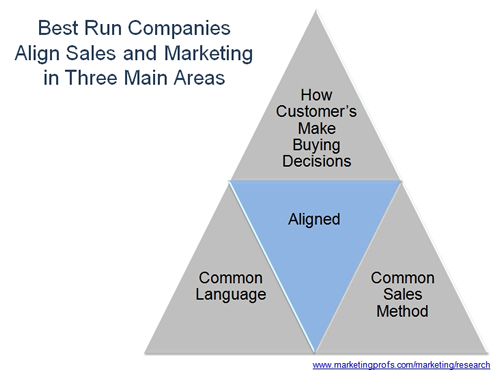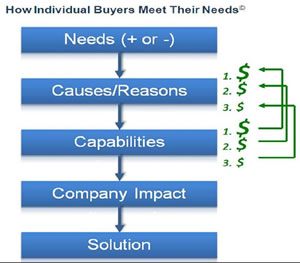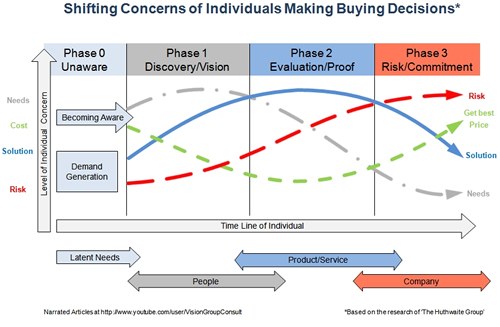Aligning Sales and Marketing Around 3 Areas Used by the Best of Breed
Aligning sales and marketing is believed to be a very difficult task. The Best of Breed have found a formula which works regardless of the size of company and the markets covered. The best news of all, the alignment of sales and marketing produces value for both the company, and the customers buying experience.
These 3 areas provide the best stability to align sales and marketing based on a 2010 study by Aberdeen and lead to 20% sales increases year over year.
The best of breed have found these 3 areas provide a solid foundation for the alignment of sales and marketing to navigate the ups and downs of the marketplace. Picture these 3 areas lined up with the 3 legs of an old milking stool which was built to be stable on uneven ground. We all know that selling in a complex B2B environment is UNEVEN ground at best.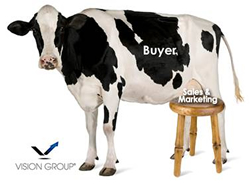
- A common language built on customer focused messaging
- How customers make buying decisions around your products and services
- A Common sales method across all product-service lines
Symptoms which are common when the 3 legs of the stool point in different directions.
- The quantity of high quality leads is not sufficient
- Sales and Marketing have yet to agree on the definition of a sales ready lead
- Visibility of opportunities moving through the sales funnel is low, they go in one end and come out the other without sales management or sales being sure what happened
The first leg of the stool is to build a common language from customer focused messages.
A paradigm which matches the first leg of the stool, "It is not About It, it is about What It Can Do." During the discovery phase of a buying cycle, it is not uncommon for Sales and Marketing to be communicating product or service details. However, during discovery, the prospect is focused on how the product or service can help them achieve their business needs based on value. They are the most interested in how the capabilities offered can be used within their business.
Discussing product or service features and benefits during the discovery phase is actually out of alignment with what the prospect is expecting in this phase of the buy-sell cycle. During discovery, the primary concern of an individual making a buying decision is their needs. Prospects are looking for ways to achieve their needs, not trying to understand the features, specifications or the details of a product or service offering. These items become a concern to the prospect during the evaluation phase, not during discovery.
One of the major changes to capture better and higher quality Sales Ready Leads is to have conversations and dialogs with prospects in their language, not our own internal jargon. Prospects expect to dialog around capabilities which can help them achieve their needs based on value during the discovery phase. Using common words and industry standards found within their vertical market or industry, not the sellers.
A quick check of the language and messaging used today is to pull up current demand generation activities. Are the words used helping the prospects visualize how to use your products and services within their business to help achieve their needs based on value?
During the creation of interest in a prospects mind, avoiding product and service details allows best of breed companies to focus on the business usage, value and the factors which influence prospects the most.. These metrics from Marketing Sherpa demonstrate the factors which resonate the most with prospects while they are looking for content during discovery.
- Specific industry (82% found this significantly or somewhat more valuable)
- Job function (67% found this significantly or somewhat more valuable)
- Company size (59% found this significantly or somewhat more valuable)
Aligning Sales and Marketing around how customers make decisions to buy your products and services is the second leg.
The paradigm here is to think in terms of, "It is not a Sales Cycle, it is a Buying Cycle." First let's break down the buy-sell cycle into 3 main phases.
- Discovery
- Evaluation
- Commitment
These buying phases come from one of the largest studies done in the past. There were in excess of 30,000 buyers interviewed during this Xerox project. The interviews were performed by the Huthwaite Group. In the study, it was determined buyers have different levels of concern as they are making a buying decision. If the seller is not in tune with the buyers concerns and which phase they are in, the seller is out of alignment with the buyer.
Understanding the buying cycle is critical when building out the second leg of sales and marketing alignment to stay in tune with new prospects and existing customers as they are making buying decisions. It is no longer a sales cycle, it is an integrated buy-sell cycle focused on the appropriate concerns of the individuals making the buying decision.
A common sales method is the third and final leg.
The sales method is saved for last, because until we know how the customer makes decisions to buy your products and services. It is difficult to create the proper sales stages and steps which line up with the buying cycle for the products and services offered.
As the sales stages and steps are being flushed out, the final paradigm becomes, "It is not about the cost per lead, it is about Sales Ready Leads." Using the buy-sell cycle as the foundation, it is time to determine where in the buy-sell cycle it makes sense for sales to interact with the opportunity.
An example of combined sales-marketing funnel-pipeline is listed below. The main stages of the sales method, (middle of diagram below), line up with the buying methods of your customers. Example details steps are listed on the right hand side. Best of breed use a common sales method across the company, and modify the details sales steps for the variances which exist within the product-service lines.
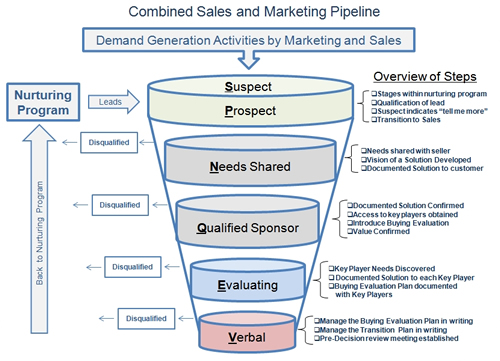
Sales and Marketing need to mutually agree upon the stage and detailed step a marketing lead is transitioned to a sales ready lead. Prior to this sales step in the buy-sell cycle, marketing is nurturing the leads, not sales. The handoff of sales ready leads from marketing is where the race is won or lost in terms of creating higher quality leads.
There is also a second important handoff when an opportunity stalls out in the sales funnel. The stalled leads need to be returned to marketing to be nurtured. Best of breed return stalled out sales ready leads to marketing to be further nurtured.
Dramatic results are being achieved in this area by recycling stalled out sales ready leads back to marketing to be nurtured. During nurturing, it is important to use the proper content and tools which line up with where the opportunity is in the buy-sell cycle. Using recycling of sales ready leads back to marketing, companies are producing 50% more high quality sales ready leads at 33% less cost.
Aligning sales and marketing is considered to be low hanging fruit by many companies. Using a common language, how customers buy, and using a common sales method to help increase sales.
